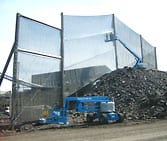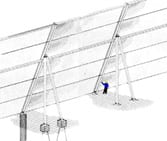Fences
Support structures are individually engineered to suit the access and load-support requirements of the site. Aerodynamic requirements also affect the design. For example, inclined fences may be needed to create the optimum sheltered zone. Some structural arrangements can also create unnecessary down-stream turbulence. For wind fences, poles are spaced anywhere from 20ft (6m) to 100 ft (30m) plus, with 60 ft (18m) being most common.
Free-standing Poles
The simplest form of construction is a pole concreted into a hole in the ground.
The poles are typically “I” section beams or tubular steel which can be supplied pre-drilled and galvanized for the cables and cladding system to attach to.
The poles may be spaced with solid beams (compression rails) between them, or anchored at each end of the fence to resist the tension in the cables.
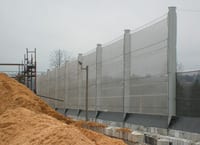
Wind fences shortly after their construction (temporary retaining wall is still in place). Shows lower section with angled near solid fabric attached to top of lock-block retaining wall. Blocks fit between the poles. Poles are 47ft (14m) high and 63ft (19m) apart.
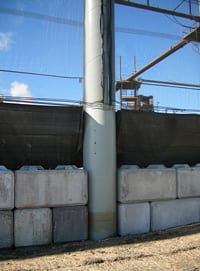 Detail showing welded splice joint on free-standing pole. Also shows lockblocks fitting around pole. |
Tripod Style Pole
Tripod poles are suitable for structures taller than 40 feet (12m). They are the most common pole for windbreaks over 60 feet as they are economical in terms of steel use, efficient in terms of ease of installation and adaptable in that they suit a range of foundation types.
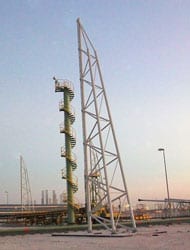
65 foot (19m) tall from a fence under construction in the Middle East.
Guyed or braced poles
Guyed or braced poles are often an economical solution- particularly for semi-circular layouts.
They are usually installed on a helical-anchor base for minimal site disruption.
They can be incorporated into existing structures such as railway trestles
There are a number of ways of bracing.
The angled system below shows a double brace for construction stability, but single braces are also effective. It also shows an inclined face to provide a ramp effect and better “throw” of the wind.
The brace may be on either side of the pole to suit access requirements. Cable guys can be used too (with vertical poles).
|
|
This is a 40 foot (12m) high fence on top of a 30 foot (9m) high berm at a coal mine in Northern British Coloumbia. A solid brace is used on the end pole, the other poles are guyed both sides with steel cables. The support systems here were chosen because of their flexibility in dealing with difficult foundation conditions

Two views of a windbreak mounted on a railway trestle in Vermont. Trestle is used for bottom-dump railcars delivering wood-chips. Shelter is 3 panels high, each panel is approx 10ft (3m) x 50ft (15m).
Windbreak under an air-cooling tower in Nevada. Panels are near-solid at the base and increase in porosity at each height
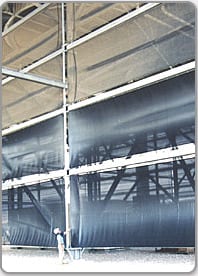 .
.

